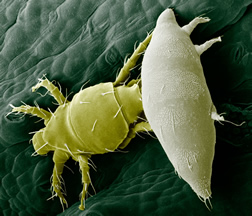This page has been archived and is being provided for reference purposes only. The page is no longer being updated, and therefore, links on the page may be invalid.
|
|
Prompt Progress Made Against a New Threat to Watermelon
By Luis PonsApril 11, 2007
A keen eye, fast action, and a vast plant collection may help nip in the bud a potential widespread threat to watermelons.
Last July, plant pathologist Chandrasekar Kousik of the Agricultural Research Service (ARS) U.S. Vegetable Laboratory in Charleston, S.C., was conducting field studies on a watermelon disease when he made a startling discovery: significant infestations of broad mites on watermelon plants.
Kousik knew that he had made a troublesome finding, as broad mites had never been reported on watermelon plants in the United States.
Broad mites, Polyphagotarsonemus latus, feed on at least 60 plant families. Cucumbers are highly susceptible to the mite, which on the watermelon plants was seen damaging tender leaves and growing tips. Watermelon (Citrullus lanatus) is an important economic commodity grown in 44 states—most prominently in Florida, Georgia, Texas, California, Indiana, South Carolina and North Carolina.
The discovery inspired Kousik, fellow Vegetable Laboratory scientists Amnon Levi and Alvin Simmons, and Clemson University researchers to seek ways to use plants' natural resistance to fight off the mite.
They turned to a collection of wild watermelon—plants from different regions of the world—maintained by the ARS Plant Genetic Resources Conservation Unit in Griffin, Ga.
The researchers studied 219 plant accessions and ultimately chose six they regarded as having the best resistance potential against broad mites. Kousik then led greenhouse studies that confirmed this resistance in the six selected introductions by artificially infesting the candidate plants with broad mites that had been cultured on susceptible watermelon plants.
According to Kousik, these wild watermelon varieties may be useful as sources of natural genetic resistance during the development of commercial watermelon varieties that resist the mites.
Identifying and developing host-plant resistance to broad mites—which are usually controlled by pesticides that can also harm beneficial parasitoids and predators—are practices that fit well into environmentally friendly crop-protection strategies, according to Kousik.
ARS is the U.S. Department of Agriculture's chief scientific research agency.

